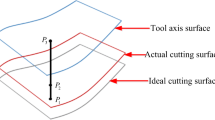Abstract
In five-axis machining of blisk, the filleted end mill has attracted more and more attention because of its larger cutting width. However, it is still a hard work to find the tool posture without interference. In this paper, a method is proposed to solve the collision-free regions. Based on the visibility of free-form surface, a tool-surface tangent model of the filleted end mill is established. With the model, only critical points on profiles of checking surface are searched with a self-adapting step length and the corresponding critical vectors are calculated and mapped to construct the collision-free regions. Firstly, critical points on the boundaries are searched according to the given precision. Meanwhile, the corresponding critical vectors are calculated and some special searched points are selected as the endpoints of each profile. Then, the adjacent critical points are searched along the profile by adjusting iteratively with a self-adapting step length in the parameter domain one by one. During the search, the corresponding critical vectors are calculated too. After that, the critical vectors are mapped to construct the subinterval collision-free regions in two-dimensions. And a method is adopted to combine collision-free regions. This algorithm is finally verified with a closed blisk and compared with a referenced method. The results show that it can efficiently solve collision-free regions in five-axis milling of blisk with a filleted end mill.




















Similar content being viewed by others
References
Lasemi A, Xue DY, Gu PH (2010) Recent development in CNC machining of freeform surfaces: a state-of-the-art review. Comput Aided Des 42(7):641–654
Tang TD (2014) Algorithms for collision detection and avoidance for five-axis NC machining: a state of the art review. Comput Aided Des 51(1):1–17
Chen KH (2011) Investigation of tool orientation for milling blade of impeller in five-axis machining. Int J Adv Manuf Technol 52(1):235–244
Liang YS, Zhang DH, Ren JX, Chen ZC, Xu YY (2016) Collision-free regions of tool orientations in multi-axis milling of blisks with a ball-end mill. Int J Adv Manuf Technol 85(5–8):1887–1900
Cai YL, Zhang FL, Xi XL (2019) Cutter orientation planning in NC machining for surface similar to revolution body with considering kinematic characteristics. Int J Adv Manuf Technol 100(1–4):503–513
Huang J, Du X, Zhu LM (2018) Real-time local smoothing for five-axis linear toolpath considering smoothing error constraints. Int J Mach Tools Manuf 124:67–79
Jun CS, Cha K, Lee YS (2003) Optimizing tool orientations for 5-axis machining by configuration-space search method. Comput Aided Des 35(6):549–566
Chen ZT, Li SS, Gan ZW, Zhu Y (2017) A highly efficient and convergent optimization method for multipoint tool orientation in five-axis machining. Int J Adv Manuf Technol 93(5–8):2711–2722
Wu BH, Liang MC, Zhang Y, Luo M, Tang K (2018) Optimization of machining strip width using effective cutting shape of flat-end cutter for five-axis free-form surface machining. Int J Adv Manuf Technol 94(5–8):2623–2633
Luo M, Yan DQ, Wu BH, Zhang DH (2016) Barrel cutter design and toolpath planning for high-efficiency machining of freeform surface. Int J Adv Manuf Technol 85(9–12):2495–2503
Tang TD, Bohez ELJ (2015) A new collision avoidance strategy and its integration with collision detection for five-axis NC machining. Int J Adv Manuf Technol 81(5–8):1247–1258
Li XY, Lee CH, Hu PC, Zhang Y, Yang FZ (2018) Cutter partition-based tool orientation optimization for gouge avoidance in five-axis machining. Int J Adv Manuf Technol 95(5–8):2041–2057
Liu W, Zhang JW, Zhu SM, Zhang CC, Yuan TJ (2017) Efficient tool posture global collision-free area generation for 5-axis point clouds machining. Int J Adv Manuf Technol 88(1–4):1013–1023
Hu PC, Tang K, Lee CH (2013) Global obstacle avoidance and minimum workpiece setups in five-axis machining. Comput Aided Des 45(10):1222–1237
Liang YS, Zhang DH, Chen ZC, Ren JX, Li XY (2014) Tool orientation optimization and location determination for four-axis plunge milling of open blisks. Int J Adv Manuf Technol 70(9):2249–2261
Wu BH, Zhang DH, Luo M, Zhang Y (2013) Collision and interference correction for impeller machining with non-orthogonal four-axis machine tool. Int J Adv Manuf Technol 68(1):693–700
Chen L, Xu K, Tang K (2015) Collision-free tool orientation optimization in five-axis machining of bladed disk. J Comput Des Eng 2(4):197–205
Lin ZW, Shen HY, Gan WF, Fu JZ (2012) Approximate tool posture collision-free area generation for five-axis CNC finishing process using admissible area interpolation. Int J Adv Manuf Technol 62(9–12):1191–1203
Bi QZ, Wang YH, Ding H (2010) A GPU-based algorithm for gen-erating collision-free and orientation-smooth five-axis finishing tool paths of a ball-end cutter. Int J Prod Res 48(4):1105–1124
Wang QH, Li JR, Zhou RR (2006) Graphics-assisted approachto rapid collision detection for multi-axis machining. Int J Adv Manuf Technol 30(9):853–863
Tang TD, Bohez ELJ, Koomsap P (2007) The sweep plane algorithm for global collision detection with workpiece geometry update for five-axis NC machining. Comput Aided Des 39(11):1012–1024
Funding
The research was supported by the National Science Foundation of China (No. 51675439).
Author information
Authors and Affiliations
Corresponding author
Additional information
Publisher’s note
Springer Nature remains neutral with regard to jurisdictional claims in published maps and institutional affiliations.
Rights and permissions
About this article
Cite this article
Wang, Z., Shi, Y., Lin, X. et al. Collision-free regions of tool posture in five-axis machining of blisk with a filleted end mill. Int J Adv Manuf Technol 104, 645–659 (2019). https://doi.org/10.1007/s00170-019-03914-9
Received:
Accepted:
Published:
Issue Date:
DOI: https://doi.org/10.1007/s00170-019-03914-9



